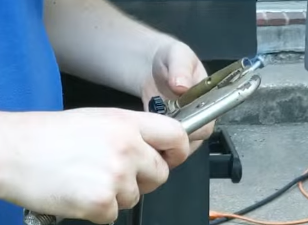I had a tiny Drinkmate CO2 tank that came with one of my soda makers. The 3oz CO2 tank wasn't worth refilling and would probably be difficult to recycle. I didn't need to exchange it for a filled tank because I have enough 14 oz tanks and I have a conversion kit to connect a 5 lb tank to the soda maker.
I decided to make the tiny tank into stove attachment for a propane torch. Disclaimer: Fire is hot, propane is flammable, do this at your own risk.
I drilled several small holes around the bottom edge of the tank for flames to come out of. Then I drilled a larger hole near the neck to insert a propane torch. I lined the hole with a gasket to keep the torch in place. The torch serves as a connection point for a propane tank, control valve, and air mixer. I could have built that from scratch, but it was simpler to use an extra propane torch.
I used a heavy block of wood as a base. I drilled a hole to mount the mini tank by screwing it in. I bent and welded two strips of metal to create a grate then added legs The goal was to be able to hold a frying pan.
At first, the burner would not stay lit, either blowing itself out or having a flashback. I tried enlarging the holes, covering the air intakes, and changing the torch to tune the stoichiometry and exit velocity.
I tested the stove by cooking fried rice. I also like making scrambled eggs with chili garlic crisp, sesame oil, soy sauce, and bell peppers, but my dad complains about the smell of the sesame oil. Our kitchen stove has a fake vent hood that is just a fan with an ineffective filter, and there aren't any windows in the kitchen. Cooking on my tiny stove keeps the smells outside and reminds me of camping.










.jpg)




















.jpg)



















